#snes demake
Explore tagged Tumblr posts
Text
youtube
SEG_FAULT
SNES demake by NyxTheShield
655 notes
·
View notes
Text









I know I was late for the 10yr anniversary. Didn't think I could add much with nothing new to post. Then I remembered I have a lot of old art I made when the first game was new and I still had a deviantart account. Yes that is an OC of mine in a couple of them.
#five nights at freddy's#fnaf#fnaf anniversary#fnaf fanart#fallout#crossover#freddy fazbear#bonnie the bunny#chica the chicken#foxy the pirate#borderlands#mangle#william afton#camera face#snes#demake
17 notes
·
View notes
Text
Been working an a demake of the binding of Isaac for the SNES. Just got a very basic enemy + tear collision working!
16 notes
·
View notes
Text
#harvest moon#story of seasons#left out harvest moon (game boy) because that itself is basically a stripped-down remake (demake?) of snes harvest moon#polls
3 notes
·
View notes
Text



i'm not much of a collector or anything but i love grabbing as many physical copies of games for series i love
i own almost all of these games in far more accessible forms on through steam or emulation and the like but there is a part of me that really likes getting particularly obtuse releases of some of my favorites like the silent hill hd collection and the old pc version of ffvii, copies that are functionally inaccessible like my childhood copy of the orange box and that physical ffxiv disc, or even releases i straight up can't play right now because i lack their required hardware like final fantasy on nes and ffvi on snes/sfc
i think the reason i'm so fascinated by the oddball releases and ports of any franchise is because some of the first video games i ever played were donkey kong land 2, a game boy demake of dkc2, and the game boy color version of donkey kong country
12 notes
·
View notes
Text
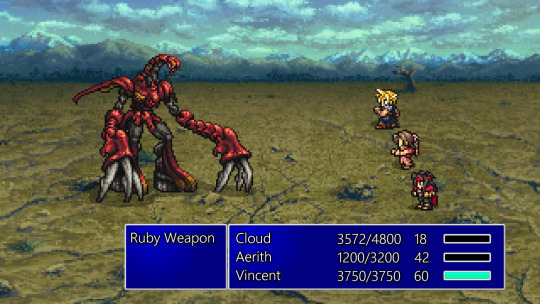
Y'know, instead of that Final Fantasy VII mobile game (Evercrisis) that remakes/remasters FF7 but also fills it full of a bunch of worthless gacha garbage, Square could have kept the ball rolling and did a Final Fantasy VII Pixel Remaster that reimagined the entire game as a SNES era Final Fantasy
And just roll on through. FF8 Pixel remaster. FF9. 10. All of them. Demake the entire franchise.
"But what about the ones with more action-y combat" I don't care. Keep them classic and turn based. Lean into it. Get weird with it. Don't be a coward!
20 notes
·
View notes
Video
youtube
[2A03+N16X]Battle! Sada/Turo 戦闘!オーリム&フトゥー Pokemon Scarlet & Violet Famit...
Awesome remix I found and had to share~~
It’d honestly be cool to see a demake of these games on the SNES/Super Famicom/Nintendo 64/etc... It’d be so neat~~
Maybe merge it with OG SMT gameplay and have gyms and other areas like titan/team star spots dungeons with enemies?
idk, lol. Demakes would be fun~~
Area Zero would be neat as an SMT dungeon maybe....
#youtube#youtube video#music#pokemon#pokemon scarlet and violet#pokemon scarlet#pokemon violet#Sada/Turo battle theme#famitracker#famitracker remix#famitracker demake#not mine#just wanted to share
7 notes
·
View notes
Text
A track-by-track thoughts post on the "Minecraft: Pixel Genesis" remix album, like what I did with the Minecraft Tetris album.
Also for the record, I listened to parts of of the original unremixed ones to get the gist before listening to their remixes (with the exceptions of Creator and Precipice, which I listen to a lot).
Featherfall (Hyper Potions Remix) - How is this the same song? I mean I guess I kinda hear it, but like. The original one is slow and ambient, meanwhile the remix feels almost like a track from an RPG. Very nice, though! I'm not too fond of the weird voice clips or whatever.
Watcher (Synthion Remix) - I like that the intro is sort of a chiptune demake of the original track, and then it kinda sounds more like something from an SNES game, before doing the sort of "bwawawawawawa" sound some music uses. You'd know it if you heard it. Also random out-of-nowhere pop at like 1:40. I like how it gets a bit more chiptuney in the background towards the end. Pretty good, even if it's the kind of music I don't normally listen to.
Puzzlebox (AIKA Remix) - The original kinda sounds ominous but calm. This remix is kinda. Not that. Honestly I don't really like this one much. Especially the random mob noises in the background.
komorebi (AIKA Remix) - I really like the unremixed version. It feels like a classic Minecraft track, all calm and piano-y, with nice ambient windchime noises as well. I am starting to cry a little bit. The remix has a nice intro that's, like, synthy and melancholic, but then it goes kinda a bit more intense and yeah I like this one!
pokopoko (Synthion Remix) - Going from the calm and slightly melancholic original version to this remix is kinda interesting. It has a kind of "end credits" feel to it that I really like. Also the chiptune aspect is fun!
yakusoku (leon chang Remix) - Damn, Kumi Tanioka's Minecraft tracks are really nice. I want to cry again. Waaah. The remix is. Fine? It kinda feels generic maybe??? Don't have much to say. Next track!
Infinite Amethyst (Snail's House Remix) - Why is Minecraft music so nice? Uhhhh anyway getting distracted. This one feels the most like what I think of when I hear the word "remix", like at the start it still sounds a bit like the original track, and then the actual remixy bit sets in and it's pretty good! Yeah.
Deeper (Elliot Hsu Remix) - Oooh, another chiptuney one! It almost feels like. You know how there are like "Smash remixes", like remixes of game music that's put in Smash Bros.? Yeah this feels like it could be one of those, like if Steve appears in Smash 6 I can totally imagine this track being in there.
Eld Unknown (Elliot Hsu Remix) - Very nice! A tiny bit closer to the kind of stuff I usually listen to. Also has a very epic feel to it!
Endless (Anamanaguchi Remix) - The original version makes me cry. That's unrelated to the topic at hand but I just wanted to say that. The remix is great! It kinda reminds me of like. Tyrian 2000. Like with the bouncy synth and adventurous tone.
Creator (leon chang Remix) - Creator is my second-favourite track on the 1.21 soundtrack! And I love the remix starting out as the actual intro before getting bitcrushed and transitioning into a more electronic version. If the original version of Creator sounds like the theme for a friendly but eccentric inventor, then this version sounds like the theme for a friendly but slightly-unethical mad scientist. Also zombie jumpscare. 10/10 remix!
Precipice (Hyper Potions Remix) - I love Precipice. It feels like JRPG final boss music. But this remix is just kinda. Fine? Like it sounds more like music that would play in a high-tech city in Pokémon or something.
4 notes
·
View notes
Text
Creative fans have reimagined 'Warframe' as a SNES game in a new YouTube video!
(Featured Image Source: 64 Bits YouTube Channel) We have talked about the creative demakes made by the YouTube Channel 64 Bits. A fun and well thought reimagining of modern games for classic consoles, the latest game to get the treatment is Warframe. A fun video showing the action-RPG third-person shooter embracing several gameplay types and visual stylings of classic SNES games. 64 Bits is a…
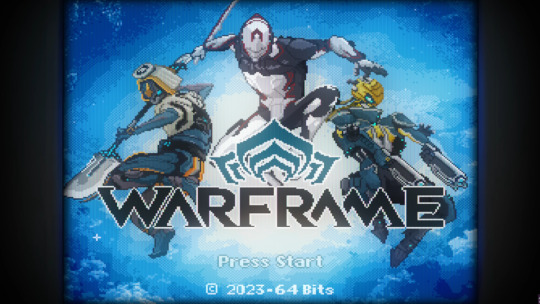
View On WordPress
4 notes
·
View notes
Text
Bad Apple!! Ultimate NES Demake Download
(此图为NES实际画面,模拟器则需要支持MAPPER128才能运行)

BILIBILI视频地址
https://b23.tv/CZUPr4m
——
https://somethingnerdy.com/downloads_files/bad_apple_ultimate_nes_demake.zip
https://somethingnerdy.com/
你敢信这是在NES实机上不用任何外挂能跑的实机视频?看看开发者是怎么说的吧,节选一小段。有兴趣的可以去看他的博客(https://somethingnerdy.com/blog/)
MXM-1 现在具有完整的、最终确定的扩展音频。它具有以下特点:
8 个 8 位单声道 PCM,最大播放速率为 44.1KHz(4 个用于 SFX,4 个用于音乐)
Sinc 函数插值,黄油般平滑,允许上下重新调整几个八度音高
2 个可配置的回声缓冲区(1 个用于 SFX,1 个用于音乐)
11 位 Δ-Σ DC
简单的波表支持细粒度的、composer 定义的循环
在任何未修改的 Famicom、安装了扩展音频桥的前置加载器 NES 或扩展修改的 toploader NES 上都能完美运行
因此,我们有了勇气,但仍然缺乏创建自己的测绘机的能力,我们推动了尽可能多地发明新技巧——办公室里所谓的“新奇事物”。我们最终创建了不少这样的...如此之多,以至于 MMC3 的 ROM 空间限制似乎确实会阻止我们充分利用它们。MMC5 允许的空间比 MMC3 多一点(大约两倍),但缺少 MMC3 的四元组���命名功能。MMC5 还具有 8×8 属性(即,屏幕着色比 NES 的 16×16 属性所允许的更密集),但该功能被硬连线为仅使用单个名称表。因此,8×8 在 MMC5 中非常糟糕,以至于它无法在硬件滚动时正常工作。整个经典的映射器情况一团糟,无论如何,没有一个现有的 NES 内存映射器允许任何地方有足够的空间来促进充满高级关卡设计、丰富配乐和音效、高帧率精灵动画、复杂背景动画或 SNES/PlayStation JRPG 大量对话的广阔游戏......更不用说像 FMV 这样疯狂的事情了。
NES 的大多数经典内存映射器都以某种方式插入 PPU。通常是为了提供比微不足道的 8KiB 的 CHR 更多,但有时这样做是为了促进 CHR-ROM 和 CHR-RAM 在同一个墨盒 (MMC3) 上,每帧提供超过 256 个图块 (MMC5),在帧中间自动切换 CHR (MMC2),以及其他原因。我们已经把所有这些都带到了逻辑上的极端;以下是详细信息:
4.1. 每个屏幕 256 个不同的图块 -> 每个屏幕 960 个独特的图块。
由于 CPU(和 PPU)的 8 位特性,NES 的设计中存在许多人为限制。其中之一是,如果没有映射器支持,你不能在单个帧上放置超过 2^8 = 256 个唯一的图块,尽管帧本身需要 960 个图块才能完全覆盖它。MMC5 将此限制取消到最多 16,384 个图块中的 960 个。MXM-0 将其进一步提升到最多 65,536 个图块中的 960 个图块。当每个场景限制为 256 个图块时,艺术家会给艺术家带来沉重的负担,即没有如此严格的限制。这可以通过缩小场景/图像或通过到处重复使用图块来实现。古典 NES 时代的典型结果是非常图案化或简单化的外观,而不是展示更复杂(“熵”)的艺术。目前,我们实现了一个扫描线计数器,它与所有映射器模式完全兼容。这有助于许多栅格技巧,例如人造视差滚动,如果没有它,这些技巧将很困难或不可能。我们还可以实现一个通用的 CPU 周期计数器,类似于 Sunsoft 的 FME-7 内存映射器中的计数器,以创建更高级的光栅技巧。很难以图形方式显示我们的��描线计数方法的优势,但它相当于能够在牺牲更少 CPU 时间的同时完成更多工作,并以更少的程序员时间和头痛完成它。然后,这些节省下来的钱可以用于制作更好的游戏。如上一篇文章所述,NES 主调色板中的真实颜色数量实际上是 425 种,而不是 54 种。但是访问这些额外的 371 种颜色很难做到,因为天真的方法是一次为整个屏幕着色,以便为整个帧获得不同的 54 种颜色,而不是在更大的色彩空间中混合和匹配它们。不太幼稚的方法是使用扫描线计数器并在帧中间切换 “emphasis bits” 以获得一些额外的颜色。
我们肯定会对 Former Dawn 中的特定特效执行此操作。应该注意的是,425 种颜色使 NES 在色彩空间大小方面接近 TurboGrafx-16 和 Genesis,但在这些系统上,颜色可以自由使用得多(但不是完全)。归根结底,NES 的可用图形功能比人们意识到的要多得多,但释放这种功能需要大量的软件工程工作,或者需要少量的硬件工程工作。我们选择两者兼而有之。我们将需要投入多少时间来充分探索各种可能性,将取决于目前未知的因素。2. DPCM 样本量扩展。(4081 字节 -> 16MiB)NES 的 2A03 CPU 的 APU 部分是硬连线的,最大 DPCM 采样长度为 4081 字节,我们已经做到了,一直到 16MiB。
https://www.timeextension.com/features/interview-how-nes-rpg-former-dawn-is-bringing-cd-rom-power-to-nintendos-8-bit-system
自从我们在 2022 年第一次看到 NES游戏《Former Dawn》项目以来,我们几乎一直盯着其开发商 Something Nerdy Studios的社交媒体,热切等待有关这款有前途的游戏的每一次新更新。
《Former Dawn》使用名为 MXM-1 的定制内存映射器将 NES 推向极限,这包括精美细致且色彩缤纷的角色精灵和背景,以及令人印象深刻的“Mode-7”式地图效果。它目前正在 Kickstarter 上进行众筹,到目前为止,该活动已经达到了 160,000 美元目标中的 115,000 美元,现在仅剩一周。
因此,我们似乎很自然地最终联系了《Former Dawn》项目制作公司Something Nerdy Studios的首席执行官兼创始人Jared Hoag,试图了解更多关于该项目的信息。Hoag 能够告诉我们更多关于为 Former Dawn 提供支持的技术,以及玩家在发布后可以期待什么。
更新 【2024 年 10 月 24 日星期四 13:30 BST】:Something Nerdy Studio公司现在发布了上周展示的悬浮靴世界地图移动机制的演示。可以从开发者的网站下载,需要 NES(或 Famicom / TinyNES)、CRT 电视和 EverDrive N8 Pro(OS v2.15 或更高版本)才能正常运行。
我们第一次发布了 Former Dawn 的 MXM-1 演示,这是一款 #NES 新的动作角色扮演游戏。需要:NTSC NES/Famicom/TinyNES、CRT 和 N8 Pro。需要扩展音频才能听到音乐。穿着悬浮靴飞来飞去!
(以下三张图片均为《Former Dawn》项目在任天堂NES上运行的实际画面)
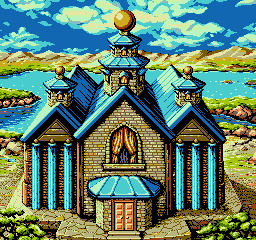
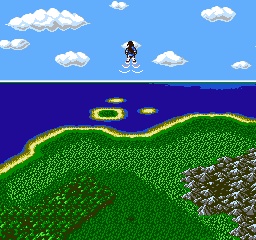

https://t.co/8jJtW5Kh3o #chiptune #8bit pic.twitter.com/thQad4CtBH— Something Nerdy Studios (@SomethinNerdy) 2024 年 10 月 23 日
有关如何安装演示的说明在 .txt 文件中提供,该文件与演示 ROM 和 mxm.rbf 文件一起分发。不过,需要注意的一点是,那些使用未启用增强音频的 NES 控制台的用户目前将无法听到游戏的音乐。因此,Something Nerdy Studio 为那些在基本的未修改的 NES 上玩游戏的人分享了本节中播放的音乐的链接。
https://www.timeextension.com/news/2024/10/think-the-nes-cant-handle-mode-7-think-again
Jared Hoag:
关于MXM-1自定义内存映射器,从项目一开始,我就想创建一个新的内存映射器,能够将 CD-ROM 数量的数据映射到 NES 的微小原生 CPU 和 PPU 地址空间。
我在这方面是受到 SegaCD 和 PC Engine CD-ROM² 扩展的启发,另一些是我在 1993 年为我的 386 PC 获得第一个 CD-ROM 扩展的经历,这是对那台386能力的一次令人兴奋的升级,尽管主板、RAM 和 CPU 没有受到影响,因为对于计算机硬盘大小更重要。
但一开始,参与该项目的人都不知道如何创建自定义映射器。当时也没有任何其他有趣的选择。
据我们所知,MMC5 是有史以来为 NES 制作的最先进的映射器,但它的 ROM/RAM 映射能力显然与我想要的差距太远。。
我凭直觉知道可以做我想做的事,但是我不得不把这个概念放在一边,而我们则研究现有的映射器——主要是MMC3——直到Dominic开始在PowerPak上查看它的Verilog源代码而且从中获得信心相信自己可以进行必要的研发来实现我的想法。
而 EverDrive N8 Pro 提供的开发环境让我们有信心将研发寄托在 Verilog 和 Flash卡上。
MXM-1主要功能有4 类:内存映射、扩展音频、Live质量、 CD-ROM 仿真。
内存映射与 MMC5 类似,但有更多的地址行可用,以获得 8-16 倍的直接内存访问。
图像上我们采用 MMC5 的 8x8 属性模式,并将其扩展到 8x1 属性,这是任天堂NES的图形硬件可以支持的最大值。
扩展音频我们是基于PCM,并受 SNES 和 Amiga 启发的精致的 8 位版本。
Live质量功能包括强大的扫描线计数器和 PPU 毛刺校正技术等。
我们还用卡带上的SD读卡器伪装成CD-ROM,并具有正确的带宽和延迟限制,其实1990年就由Codemasters公司开发任天堂NES的CD-ROM,但上市前放弃了。
0 notes
Text
"64 Bits - Elden Ring Demake for SNES"
youtube
4 notes
·
View notes
Photo



Singled out sprites from the ClayFighter demake! Sprites glorious sprites, Tiny, Helga, Bad Mr Frosty and a bonus Ickybod Clay and The Blob fill out the roster! Also included that nasty noggin bash from Taffy to Blob! Finally wrapping it up we can have a ganders at the backgrounds free from all that UI and character clutter! If you liked these sprites, please visit my Patreon. Any amount thrown my way helps and is greatly appreciated! Thanks!
[Patreon] [Twitter] [Instagram]
#pixel#art#pixel art#ドット絵#clayfighter#clay fighter#claymation#fighting#game#fighting game#super nintendo#snes#nintendo#game boy#mspaint#2bit#demake#gbdemake
41 notes
·
View notes
Text
More Isaac for SNES progress! Enemies now have pathfinding towards the player. Algorithm is a little chunky at 77k cpu cycles, but I can reduce its impact by only evaluating every few frames.
Also shown here is tear knockback.
9 notes
·
View notes
Photo
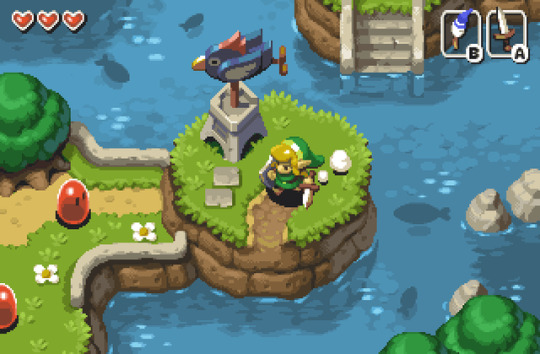
Simon S. Andersen | Zelda mockup
12 notes
·
View notes
Photo

Magical Quest Nes n' Game Boy Colors
Mickey, Minnie and Donald from the Magical Quest trilogy, with the color limitations of a Nes and a Game Boy. Mickey, Minnie y Donald de la trilogia de Magical Quest, con las limitaciones de colores de una Nes y una Game Boy.
7 notes
·
View notes
Photo

Snow In Summer
What if Nier was a SNES game?
171 notes
·
View notes